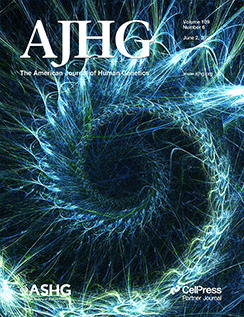人类纤维性发育不良骨的单细胞分析显示,内皮细胞、血管周围细胞和基质细胞中存在纤维化转录组和GNAS变异
IF 8.1
1区 生物学
Q1 GENETICS & HEREDITY
引用次数: 0
摘要
遗传镶嵌是人类一生中疾病的主要原因。改进检测体细胞嵌合体的工具,并应用它们来了解导致疾病的细胞和分子机制,对改善人类健康至关重要。纤维性发育不良(FD)是由体细胞、花叶型GNAS变异引起的Gs-GPCR激活的一种典型疾病(c.602G> a [p. 591])。[a] [c] [c];[201cys]),导致骨质纤维化。利用单细胞RNA测序和GNAS基因分型策略,我们分析了FD和非FD人骨的非造血细胞。FD骨显示成纤维细胞组成改变,伴有FD特异性成骨细胞簇。令人惊讶的是,除了骨骼基质细胞系外,内皮细胞和血管周围细胞也表达GNAS c.602G>;A和c.601C>;T变体,这一点通过BaseScope得到证实,表明这些变体存在于多种非成骨细胞谱系中。我们还在FD细胞系中发现了一个共同的纤维化转录组特征。我们的研究结果强调了GNAS嵌合对FD细胞和转录组学格局的影响,鉴定了以前未被识别的可能与FD发病机制相关的细胞类型,并重新构建了我们对GNAS c.602G>A (p.g arg201his)和c.601C>T (p.g arg201cys)在骨中的功能的理解。本文章由计算机程序翻译,如有差异,请以英文原文为准。
Single-cell analysis of human fibrous dysplasia bone reveals a fibrotic transcriptome and GNAS variants in endothelial, perivascular, and stromal cells
Genetic mosaicism is a leading cause of human disease across the lifespan. Improving the tools to detect somatic mosaicism and applying them to understand the cellular and molecular mechanisms that contribute to disease is of critical importance for improving human health. Fibrous dysplasia (FD) is a prototypical disease of Gs -GPCR activation caused by somatic, mosaic GNAS variants (c.602G>A [p.Arg201His] or c.601C>T [p.Arg201Cys]) that result in fibrotic bone. Utilizing single-cell RNA sequencing and a GNAS genotyping strategy, we analyzed non-hematopoietic cells from FD and non-FD human bone. FD bone showed an altered fibroblast composition with an FD-specific osteoblastic cluster. Surprisingly, in addition to the skeletal stromal lineages, endothelial and perivascular cells also expressed GNAS c.602G>A and c.601C>T variants, which was confirmed using BaseScope, suggesting that these variants are present in multiple non-osteogenic cell lineages. We also identified a common fibrotic transcriptomic signature across FD cell lineages. Our results highlight the effects of GNAS mosaicism on the cellular and transcriptomic landscapes of FD, identify previously unrecognized cell types that may be relevant to FD pathogenesis, and reframe our understanding of GNAS c.602G>A (p.Arg201His) and c.601C>T (p.Arg201Cys) function in bone.
求助全文
通过发布文献求助,成功后即可免费获取论文全文。
去求助
来源期刊
CiteScore
14.70
自引率
4.10%
发文量
185
审稿时长
1 months
期刊介绍:
The American Journal of Human Genetics (AJHG) is a monthly journal published by Cell Press, chosen by The American Society of Human Genetics (ASHG) as its premier publication starting from January 2008. AJHG represents Cell Press's first society-owned journal, and both ASHG and Cell Press anticipate significant synergies between AJHG content and that of other Cell Press titles.

 求助内容:
求助内容: 应助结果提醒方式:
应助结果提醒方式:


